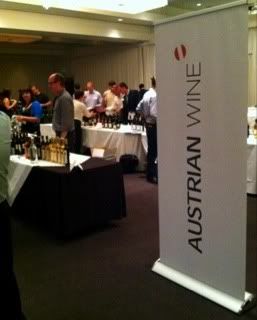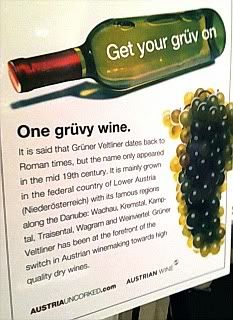The idea was, we would each receive a shipment of wines to taste and tweet about through the magic of social media. Some of us found that the delivery service had trouble getting the wines to us in time, but I already had a bit of experience with the Red Tail Ridge wines. I had met Irelan at a wine tasting event in Los Angeles earlier in the year.
Red Tail Ridge, I discovered while tweeting, is the first LEED Gold certified green winery in New York state. The steps they have taken to leave a smaller footprint has reduced the winery’s energy consumption by over 50 percent.
There were plenty participants in the Twitter tasting making comments about the orange peel they were enjoying on the RTR Dry Riesling, the pairability of the Semi-Dry Riesling and the spicy, leathery notes on the Pinot Noir. I found the wines of Red Tail Ridge to be outstanding, and a very good indication that the Finger Lakes region is bringing a lot more than Riesling to the table. Here are my notes on the wines kindly provided by Red Tail Ridge.
Pinot Noir Finger Lakes 2010
This estate-grown Pinot was hailed by the Twitter tasting group for its fruit and earthiness as well as its notes of leather and spice. It is very light in color - quite a pretty violet hue - and you can see right through it in the glass. Aromas of raspberry and cherry are framed in a beautiful earthiness. The palate shows great fruit, with only a hint of tartness - but that mineral-laden earth shows up here, too. That’s a real grabber for me. I also like a wine with good acidity, which is present in this Pinot as well. The tannins are not terribly assertive, and that’s how I like them in a Pinot. The minerals last into the finish with a bit of citrus in the background.
Blaufränkisch Finger Lakes 2009 ($23)
It’s unusual to run across Blaufränkisch and Dornfelder grapes outside of Europe. That’s no doubt why Red Tail Ridge makes these two wines under the Obscure Red Varietal Series banner. The Blaufränkisch comes in a Cabernet-style bottle, while the Dornfelder is packaged in a Pinot Noir-style bottle.
The Blaufränkisch grape is quite popular in Central and Eastern Europe, but it certainly qualifies as an obscure grape in the United States. This wine is 12% abv, and is aged in older American oak barrels. The nose smells mainly of spiced cherries - quite aromatic, with an herbal note and a floral aspect, as well as a trace of earth and minerals. It’s really a beautiful bouquet. On the palate, spices are at play with cherries. There’s a racy acidity and a forceful tannic structure giving this wine great backbone. The medium mouthfeel and the acidity work together to make it a refreshing sip.
Dornfelder Finger Lakes ($20)
This non-vintage novelty is a blend of the winery’s 2009 and 2010 vintages. The wine is estate grown, aged in older French oak barrels and carries a 12% abv number. The Dornfelder grape is quite popular in Germany. It was created in 1955 by grape breeder August Herold, but it was not made available for cultivation and use in German wine until 1979. The vines on the Red Tail Ridge property were planted in 2007.
Aromas of cherries and blackberries mix with a green floral component, but the nose is not as spicy or aromatic as the Blaufränkisch. Wonderful fruit shows on the palate, mainly black cherry and plum. The acidity is nice and refreshing while the tannins are perky, but neither element is as pronounced as in the Blaufränkisch.
Semi-Dry Riesling Finger Lakes 2010 ($16)
The semi-dry is estate grown, from RTR Vineyard. The wine is fermented in stainless steel with no malolactic fermentation and carries an alcohol content of 12% abv. It's pale in the glass, with a nice, aromatic nose showing tons of peaches and tropical fruit. There is also the slightest aroma of petrol. It is full in the mouth, despite the lack of oak and malolactic. The sweetness is there, but a tart fruit flavor follows it up and a limeade acidity carries through on the finish. I get a hint of petrol on the finish, too. It makes me want some Thai food, or a spicy Italian sausage to pair with it.
Dry Riesling Finger Lakes 2010 ($19)
This Riesling is also fermented in stainless steel with no malolactic fermentation. The alcohol content is also a low 12% abv. On the nose, this pale wine shows a bit more minerality than the semi-dry. A beautiful slate aroma paves the way for the peaches and nectarines, with a nutty hint following. The palate on this dry Riesling shows plenty of citrus and zesty flavors along with a wet rock minerality. The acidity is brisk and it imparts a refreshing quality to the sip. I'd love it with some crab, or even just mixed greens.
Follow Randy Fuller on Twitter
Follow Red Tail Ridge WInery on Twitter



 As is the case at wine tasting events where there is a proliferation of one particular type of wine, I experienced palate fatigue and the Gruner Veltliners all started to taste the same. I've experienced the same thing at events that were heavy on Pinot Noir, Tempranillo and Albarino. Mixing it up made for a good palate cleanser. I'd taste whites for a while, then reds, then back to whites. I even went across the property and sampled a few Ribera Tempranillos at another event going on at the same time. As good as those Spanish wines were, I didn't stay long. I couldn't wait to get back to Austria.
As is the case at wine tasting events where there is a proliferation of one particular type of wine, I experienced palate fatigue and the Gruner Veltliners all started to taste the same. I've experienced the same thing at events that were heavy on Pinot Noir, Tempranillo and Albarino. Mixing it up made for a good palate cleanser. I'd taste whites for a while, then reds, then back to whites. I even went across the property and sampled a few Ribera Tempranillos at another event going on at the same time. As good as those Spanish wines were, I didn't stay long. I couldn't wait to get back to Austria. As I mentioned earlier, the wines of
As I mentioned earlier, the wines of